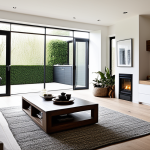Influence of Recent UK Home Design Trends on Daily Routines
Recent UK home design trends profoundly reshape how residents structure their daily routines and spatial use. A leading shift is the widespread adoption of open-plan living, which encourages greater family interaction by removing barriers between kitchens, dining, and lounge areas. This design allows multi-tasking, such as cooking while supervising children, making daily activities more fluid and connected.
In addition to open-plan layouts, the surge in home office integration greatly influences work patterns. Many UK households now prioritize dedicated, ergonomic workspace within common areas or separate rooms. This adaption supports growing remote work, balancing professional and domestic demands with smarter space allocation.
This might interest you : What Are the Unmissable Fashion Events for Women in the UK This Year?
Moreover, flexible, multi-functional spaces are becoming essential to accommodate changing life stages or activities. Rooms can transform from exercise zones to guest accommodations or hobby workshops, responding to evolving lifestyle needs without requiring larger homes. This adaptability eases the pressure of static room purposes, aligning with dynamic daily routines prevalent in modern UK living.
Together, these trends highlight a stark lifestyle adaptation, where design choices directly improve convenience, social interaction, and efficiency in everyday life.
In parallel : How is Brexit impacting the UK automotive export market?
The Role of Sustainable Materials in UK Lifestyles
The rise of sustainable design marks a pivotal trend in UK home design trends, profoundly affecting daily routines and lifestyle adaptation. Homeowners increasingly prioritize eco-friendly homes, driven by environmental awareness and the desire to reduce their carbon footprint. This shift means incorporating materials like recycled timber, reclaimed bricks, and low-VOC paints, which not only minimize ecological impact but also promote healthier indoor air quality.
Consumer purchasing decisions now heavily weigh sustainability credentials, influencing everyday habits such as waste reduction, energy-efficient appliance use, and water conservation. For example, residents in eco-conscious homes often adapt routines like composting kitchen waste or using rainwater harvesting systems, embedding green living UK principles into daily life.
Case studies demonstrate successful eco-friendly home transformations, showcasing innovations such as solar panel integration and natural insulation materials. These adaptations align with current UK home design trends by reinforcing flexibility and comfort while supporting environmental goals. Thus, sustainable design is no longer a niche; it’s an essential component reshaping UK household behaviors and lifestyle adaptation at a foundational level.
Technology Integration and Smart Living Choices
Emerging UK home design trends increasingly include smart home technology, fundamentally transforming daily routines and lifestyle adaptation. The adoption of smart devices—from thermostats to lighting and security systems—enables residents to automate tasks, making homes more energy-efficient and responsive to individual needs. For example, smart thermostats adjust heating patterns based on occupancy, optimizing energy consumption without manual input.
How is technology changing home management? Smart home technology centralizes control through apps, allowing seamless management of appliances, lighting, and security remotely. This digital convenience links to lifestyle adaptation by maximizing time efficiency and enhancing home comfort without constant manual adjustments. Additionally, integration of voice-activated assistants supports multitasking and accessibility, particularly important for busy households balancing diverse activities.
Smart security solutions, including motion sensors and connected alarms, improve safety while reducing stress. Entertainment systems linked to digital households in the UK provide personalized media experiences, aligning with leisure trends. The rapid integration of tech in interior design elevates functionality without sacrificing aesthetics, reflecting a shift toward holistic lifestyle adaptation where technology complements modern living demands efficiently and elegantly.
Social and Cultural Shifts Reflected in Design Preferences
Design preferences in the UK increasingly mirror social trends in design and broader cultural lifestyle shifts. Modern UK homes balance communal and private spaces, reflecting evolving values that prioritize both connection and individual privacy. Open-plan living remains popular for its social benefits, yet dedicated private retreats address the need for personal downtime amid busy routines.
How does cultural diversity shape home aesthetics and layouts? The rich multicultural landscape inspires eclectic interior styles and functional adaptations. For instance, British households often incorporate design elements from varied cultural heritages, promoting inclusivity and personalization. This cross-cultural influence fosters a lifestyle adaptation that honors diversity while creating cohesive, welcoming environments.
Examples of design reflecting greater inclusivity include adaptable layouts for multigenerational living and spaces designed for accessibility. These trends support diverse family structures and changing demographics, responding directly to shifting UK societal patterns. Through thoughtful design, homes not only accommodate but celebrate lifestyle diversity, aligning spatial use with values that underpin modern life in the UK.
Expert Insights and Evidence: How Home Design Trends Drive Lifestyle Change
Expert opinions increasingly highlight the profound impact of UK home design trends on daily routines and lifestyle adaptation. Research consistently links open-plan living designs with improved family interaction and overall well-being, confirming that spatial choices affect social habits and time management.
Statistical data from recent UK studies show that over 60% of homeowners now incorporate flexible multi-purpose rooms, reflecting a strong shift toward adaptable living that supports changing routine demands. Experts emphasize that such flexibility is essential to accommodate diverse family needs and evolving work-from-home practices.
Lifestyle impact research UK further reveals that homes equipped with integrated workspaces and smart technology report higher satisfaction in balancing domestic and professional life. This evidence underscores how design innovations directly shape residents’ behaviours, promoting efficiency and comfort.
Looking ahead, specialists predict a growing emphasis on holistic design strategies that fuse sustainability, technology, and cultural inclusivity to foster healthier and more responsive living environments. These insights solidify the role of modern home design as a key driver in shaping everyday life across the United Kingdom.






